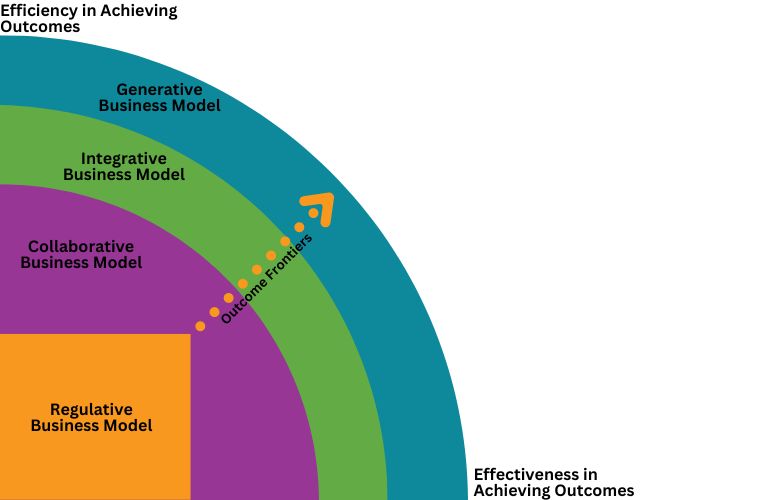The Human Services Value Curve is a strategic framework that helps guide human services organizations to enhance their performance and deliver more value to their clients. Human services programs new to the concept want to know – what is the Human Services Value Curve? When we delve deeper into this concept and how it can be applied to your human services programs, it’s essential to consider the role of innovative solutions like NCT CaseWorks casefile management system. By employing innovative tools and adapting the information provided by the Human Services Value Curve, organizations can progress and improve, thereby increasing their capacity to create positive outcomes for those they seek to help.
The Human Services Value Curve is a progressive model that outlines the evolution of human services organizations as they strive to deliver greater value and impact in their communities with an emphasis on efficiency and effectiveness. This model is divided into four distinct horizons – Regulative, Collaborative, Integrative, and Generative – each represents a different level of organizational maturity and capability.
- The Regulative Horizon represents the most basic level of service delivery, where organizations primarily focus on regulatory compliance and direct service provisions. The emphasis here is on following rules and maintaining stability.

- The Collaborative Horizon involves organizations beginning to work together to coordinate services. This level sees an increase in efficiency and effectiveness as human services organizations share resources and knowledge to improve outcomes for individuals and families.
- The Integrative Horizon is characterized by organizations that not only collaborate but also integrate their services to provide a seamless experience for the individuals and families they serve. This level involves a more holistic approach to service delivery, addressing multiple aspects of clients’ needs.
- The Generative Horizon represents organizations that have mastered the previous levels and are now innovating and generating new solutions to complex human services problems. These organizations are leaders in their field, driving systemic change and creating significant social impact in larger communities and populations
How To Apply the Human Services Value Curve to Your Program?
Applying the Human Services Value Curve to your program can take many forms and involves a strategic and phased approach in most cases. The first step is to start by identifying which horizon or stage your program currently operates in. Human services organizations in the Regulative stage can put focus on improving compliance and direct service provision. Organizations in the Collaborative stage can seek additional partnerships that can enhance their ability to deliver services to individuals, families and communities. Those in the Integrative stage can work on creating a seamless service experience by addressing multiple aspects of people’s needs. The human organizations in the Generative stage should continue to innovate and drive systemic change in local governments and communities.
The best way to apply the Human Services Value Curve to your organization is to use it as a framework for an honest self assessment and look at specific areas in need of improvement. Remember – the goal is to progress along the curve, enhancing your capacity to deliver value and impact at each stage. Regular assessments and adjustments are key to this evolutionary process.
Here are a few questions you can ask in your assessment process that will help you unlock the potential of the Human Services Value Curve.
List of Human Services Value Curve Questions
- How can we be more efficient and effective?
- In which areas can we be more effective and efficient?
- What are the ideal outcomes for our clients and how can we be more creative in achieving those outcomes?
- What opportunities do we have to collaborate with other human services organizations?
- Do we have the right tools and resources to achieve maximum effectiveness and efficiency?
- Do we have the time and resources to improve our service capabilities?
- What technology is available to help us improve our service?
- How will caseworkers adapt to potential changes?
How Can NCT CaseWorks Help?
A key element of the Human Services Value Curve is efficiency – and that is where NCT CaseWorks can help your organization improve the most. CaseWorks is an innovative content management platform that is built for human services organizations to help make document management and workflow automation more efficient. NCT CaseWorks will support financial services, child support, social services, healthcare, accounting, and workforce programs.
Human services organizations that look at the Human Services Value Curve and determine that they need to find ways to be more efficient and need the right tools and technology to be more effective in day-to-day operations may find that NCT CaseWorks is the solution. NCT CaseWorks can help caseworkers mitigate the time spent on paperwork, help you better interact with peers, and help you be more efficient, effective, and productive.
READ MORE: How Does Productivity Software Help Social Workers?
The Human Services Value Curve provides a strategic roadmap for human services organizations to enhance their ability to serve individuals, families, and communities. As organizations navigate through the horizons of this curve, tools like NCT CaseWorks can play a pivotal role in increasing efficiency and improving service delivery. By streamlining document management, NCT CaseWorks allows organizations to focus more on their mission and less on administrative tasks.
If you’re ready to elevate your organization’s position on the Human Services Value Curve, don’t hesitate to contact NCT Inc. Their team is ready to help you leverage technology to drive your mission forward and create lasting impact!






